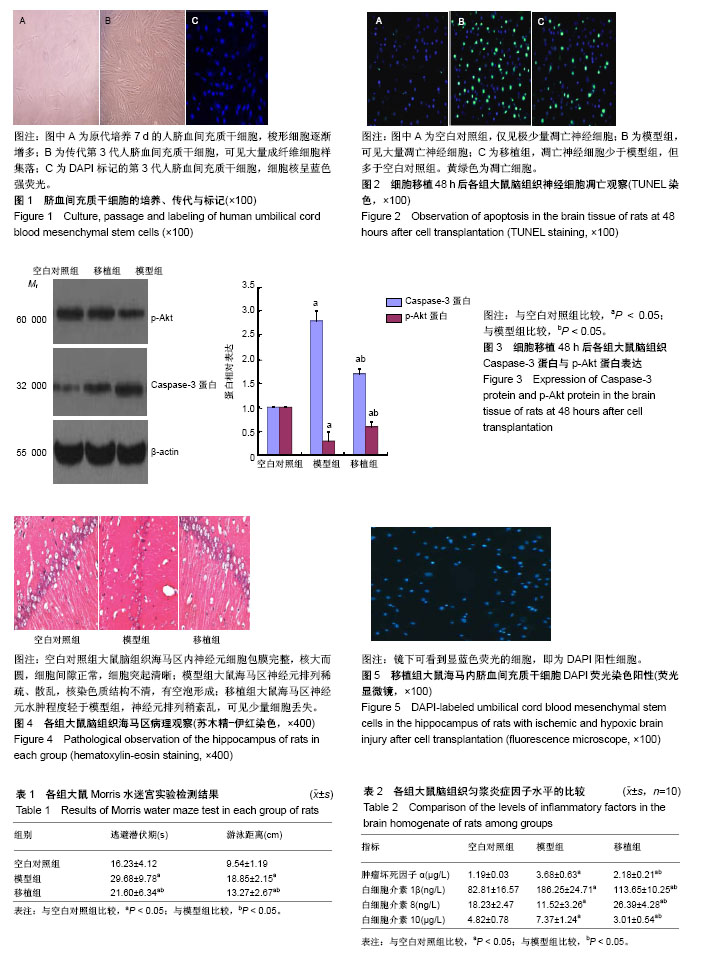| [1] 李丽珍,陈成彩,梁玉美,等.新生儿缺氧缺血性脑病的发病机制及诊断进展[J].右江民族医学院学报,2017,39(5):397-399.[2] Massaro AN, Govindan RB, Vezina G, et al. Impaired cerebral autoregulation and brain injury in newborns with hypoxic-ischemic encephalopathy treated with hypothermia. J Neurophysiol. 2015;114(2):818-824. [3] Tamplin OJ, Durand EM, Carr LA, et al. Hematopoietic stem cell arrival triggers dynamic remodeling of the perivascular niche. Cell. 2015;160(1-2):241-252. [4] 陈阳,宋良萍,察鹏飞,等.水动力辅助吸取成人脂肪来源干细胞的体外分离、培养和鉴定研究[J].中国美容医学,2018,27(1):77-80.[5] 王雪丽.骨母特异性因子2促进瘢痕疙瘩间充质干细胞体外增殖的研究[D]. 重庆:陆军军医大学, 2017.[6] 朱向情,王强,蔡学敏,等.新生猕猴UCMSC的制备、鉴定及对老年猕猴自发DM的治疗作用[J].西南国防医药,2018,2(1):16-19.[7] Li J, Guo W, Xiong M, et al. Erythropoietin facilitates the recruitment of bone marrow mesenchymal stem cells to sites of spinal cord injury. Exp Ther Med. 2017;13(5):1806-1812. [8] Feng Y, Ju Y, Cui J, et al. Bone marrow stromal cells promote neuromotor functional recovery, via upregulation of neurotrophic factors and synapse proteins following traumatic brain injury in rats. Mol Med Rep. 2017;16(1):654-660. [9] 汪皖君,管雅琳,王雅静,等.骨髓间充质干细胞移植对大鼠脑缺血再灌注损伤的神经保护作用[J].中风与神经疾病杂志, 2016, 33(11):1017-1020.[10] Ali EHA, Ahmed-Farid OA, Osman AAE.Bone marrow-derived mesenchymal stem cells ameliorate sodium nitrite-induced hypoxic brain injury in a rat model.Neural Regen Res. 2017; 12(12):1990-1999.[11] 曹蕊,严笠,张辰,等.人小涎腺间充质干细胞与骨髓间充质干细胞的增殖和成脂比较[J].中国美容医学,2017,26(5):31-35.[12] Guo L, Yin F, Meng HQ, et al. Differentiation of mesenchymal stem cells into dopaminergic neuron-like cells in vitro. Biomed Environ Sci. 2005;18(1):36-42. [13] 王丹妮.人脐血间充质干细胞与大鼠骨髓间充质干细胞神经分化的实验研究[D]. 北京:首都医科大学,2008.[14] Dong HJ, Shang CZ, Li G, et al. The distribution of transplanted umbilical cord mesenchymal stem cells in large blood vessel of experimental design with traumatic brain injury. J Craniofac Surg. 2017;28(6):1615-1619. [15] 吴芳,杨佳勇,张敏,等.脐血间充质干细胞移植对脑性瘫痪儿童神经系统功能的影响:20例分析[J].中国组织工程研究与临床康复, 2008,12(16):3198-3200.[16] 徐春香,张琴芬,黄颖兰,等.新生鼠缺血性脑损伤行人脐血间充质干细胞移植两种注射途径比较[J].护理学杂志, 2014,29(3): 43-45.[17] 庞炜.新生儿缺氧缺血脑损伤大鼠模型制备以及间充质干细胞对模型损伤疗效的研究[D]. 广州:南方医科大学, 2016.[18] 杨静丽,乔丽丽,程秀永,等.脂多糖与缺氧缺血对新生大鼠脑损伤的协同作用[J].中国急救医学,2003,23(1):1-2.[19] Kim M, Yu JH, Seo JH, et al. Neurobehavioral assessments in a mouse model of neonatal hypoxic-ischemic brain injury. J Vis Exp. 2017;(129). doi: 10. 3791/55838. [20] Wu W, Wei W, Lu M, et al. Neuroprotective Effect of Chitosan Oligosaccharide on Hypoxic-Ischemic Brain Damage in Neonatal Rats. Neurochem Res. 2017;42(11):3186-3198. [21] 宋文杰,沈瑞乐,武海波.两种新生大鼠缺氧缺血性脑损伤模型制备的比较[J].中国误诊学杂志,2005,5(17):3221-3223.[22] 周龙,林也容,陈慧,等.MgSO4对急性胎兔宫内窘迫脑损伤NMDAr1表达影响的病理学研究[J].中国当代医药, 2013,20(36): 11-13.[23] 吴至凤,温恩懿,赵聪敏,等.针刺对发育期脑损伤大鼠脑组织细胞凋亡及Bcl-2、Bax蛋白表达的影响[J].重庆医学, 2010,39(21): 2898-2900,2903.[24] 王海伟,王自勤,苏丹,等.参茸益精片对急性高原缺氧脑损伤的保护作用研究[J].实用药物与临床,2017,20(10):1112-1115.[25] Qiao L, Fu J, Xue X, et al. Neuronalinjury and roles of apoptosis and autophagy in a neonatal rat model of hypoxia-ischemia-induced periventricular leukomalacia. Mol Med Rep. 2018;17(4):5940-5949. [26] Cui D, Sun D, Wang X, et al. Impaired autophagosome clearance contributes to neuronal death in a piglet model of neonatal hypoxic-ischemic encephalopathy. Cell Death Dis. 2017;8(7):e2919. [27] Li D, Luo L, Xu M, et al. AMPK activates FOXO3a and promotes neuronal apoptosis in the developing rat brain during the early phase after hypoxia-ischemia. Brain Res Bull. 2017;132:1-9. [28] 熊飞,詹瑧,唐于平,等.PI3K/Akt信号转导通路在非小细胞肺癌中的作用[J].中国药理学通报,2010,26(10):1264-1267.[29] 王维,张琍.P13K/Akt信号转导通路的研究进展[J].现代医药卫生, 2010,26(7):1051-1052.[30] 姜恩平,王帅群,王卓,等.北五味子总木脂素对脑缺血模型大鼠神经细胞凋亡及p-AKT表达的影响[J].中国中药杂志, 2014,39(9): 1680-1684.[31] Zhou ZQ, Li YL, Ao ZB, et al.Baicalin protects neonatal rat brains against hypoxic-ischemic injury by upregulating glutamate transporter 1 via the phosphoinositide 3-kinase/ protein kinase B signaling pathway.Neural Regen Res. 2017;12(10):1625-1631.[32] Driscoll DJO', Felice VD, Kenny LC, et al. Mild prenatal hypoxia-ischemia leads to social deficits and central and peripheral inflammation in exposed offspring. Brain Behav Immun. 2018;69:418-427. [33] Huang J, Zhang L, Qu Y, et al. Histone acetylation of oligodendrocytes protects against white matter injury induced by inflammation and hypoxia-ischemia through activation of BDNF-TrkB signaling pathway in neonatal rats. Brain Res. 2018;1688:33-46. [34] 刘慧娟,戴王娟,康树敏,等.骨髓间充质干细胞移植对缺氧缺血性脑损伤大鼠脑内肿瘤坏死因子-α及白细胞介素-1β水平的影响[J].中华围产医学杂志,2016,19(4):301-307.[35] 陈瑶,张馨月,陆玉霞,等.脐血间充质干细胞分化为神经样细胞的诱导因素的比较及优化[J].临床检验杂志, 2016,3(9):669-673.[36] 赵迪诚,杜鹃,陈红,等.脐血间充质干细胞治疗大鼠脑缺血性损伤的实验研究[J].中华全科医学,2012,10(2):172-173,182. |
.jpg)

.jpg)